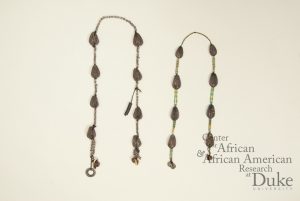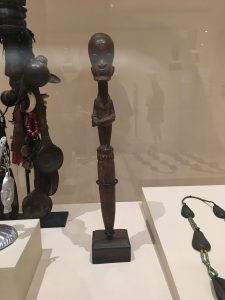

The object that I chose to study is the Beaded Thunderstone of God Changó. This is an eight inch tall artifact with columns of red beads around a stone which is seen at the base. These columns are separated by putty with gems in them. Changó makes an appearance near the top as a black figure in gold and red garments with a plastic eye above his golden cap. The object itself is quite beautiful, yet it doesn’t seem like it could have any use outside of being a piece of art. This leads to me think about the significance of Thunderstone to the cultures it belongs to, as well as the processes that lead to it becoming important in those cultures. I hope that in understanding about the purpose of the Thunderstone, I can learn about what makes these objects so much more than just objects to these cultures.
Throughout the year we have read articles from a variety of scholars discussing fetishes, rituals, and events that are part of the African Diaspora. Much of what we read discussed the actions and activities that different groups would participate in. The descriptions would sometimes include backstories, or explanation, but couldn’t get at the significance of what was happening. “Here the tip of the cone is perforated, to receive a single nail, which is meant to suggest the wonder-working knife of Eshu Odara, who worked miracles with a knife erect upon his head”(Flash of Spirit, 25). This description does a good job of matching the details of the art to the Orişa, but gives very little to its purpose in the life of the Yoruba people. I want to understand the significance of the individual Thunderstone so that I can apply that understanding to the rest of the culture, and learn without the bias of Western Culture.
To understand the purpose of the Thunderstone, I must find some form of evidence that contains the information I want. The first primary source that I think will be most useful, would be interviews with the people devote to the African Diaspora. Looking specifically at the influence of the Orişa Changó in their lives would be the most ideal interview available, but most interviews discussing their culture would be beneficial. Another primary source that would be useful to look at would be other pieces of art or fetishes from Changó. With these, I could look for an overall purpose from how Changó is represented to his followers. A secondary source with the analysis of Changó’s influence on the African Diaspora culture I think will help significantly in pulling out the most information I can from the primary sources. I believe it will give a sufficient introduction to Changó and his place in the African Diaspora, so much so that looking at the actual religion will allow me to connect to it.
Joe Petrozzino


